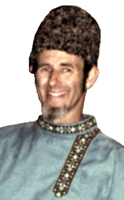
|
The Society of Folk Dance Historians (SFDH)
English Steps, Terms, and Styling
[
Home |
About |
Encyclopedia | CLICK IMAGE TO ENLARGE |

|
WALKING AND RUNNING STEP
The walking step should fall on the ball of the foot, with the heel off, but close to the floor and the feet held straight and parallel. All unnecesssary movements should be suppressed, such as kicking the feet or raising the knees.
The runing step is the same movement with a more noticeable spring in the step and is executed neatly and lightly.
SKIPPING STEP
The skipping step is a step-hop on alternating feet and is in the same character as the running step.
Hop L (ct &); land on ball of L ft with heel close to floor (ct 1); hop on ball of L ft (ct &); step onto ball of R ft (ct 2).
Repeat starts with hop on R ft.
RANT STEP
The Rant step is from northern England and is similar to a polka step but is smalleer and more vibrant.
BOW AND CURTSEY
The bow and curtsey are used at the beginning and end of each dance on chord.
Men bow from the waist, back straight, hands easy at the sides, looking at his partner.
Women take a tiny step sideward (or forward), bring the toe of the left foot close to the right heel, and bending both knees, keep the body erect and look at her partner.
Then both return to easy standing position taking weight onto the left foot to prepare for the dance.
Women's skirts may be held between thumbs and middle fingers, elbows kept almost straight and wrists bent forward.
GENERAL STYLING
The weight of the body must always be supported wholly on one foot or the other, and never carried on both feet at the same moment. The motivating force of the dance comes from the foot spring and the inclination of the body as it leans into the direction it is going. The body is essentially carried in-line from head to foot, without bend at the neck, waist, or knees but it is not held stiff. The arms are allowed to swing quietly and loosely at the sides, except when necesssary for balance. When arms are used they should support, guide, and regulate the woman's movement.
DOCUMENT
- England, a country.
From the Idyllwild Folk Dance Workshop 1973 syllabus.
This page © 2018 by Ron Houston.
Please do not copy any part of this page without including this copyright notice.
Please do not copy small portions out of context.
Please do not copy large portions without permission from Ron Houston.